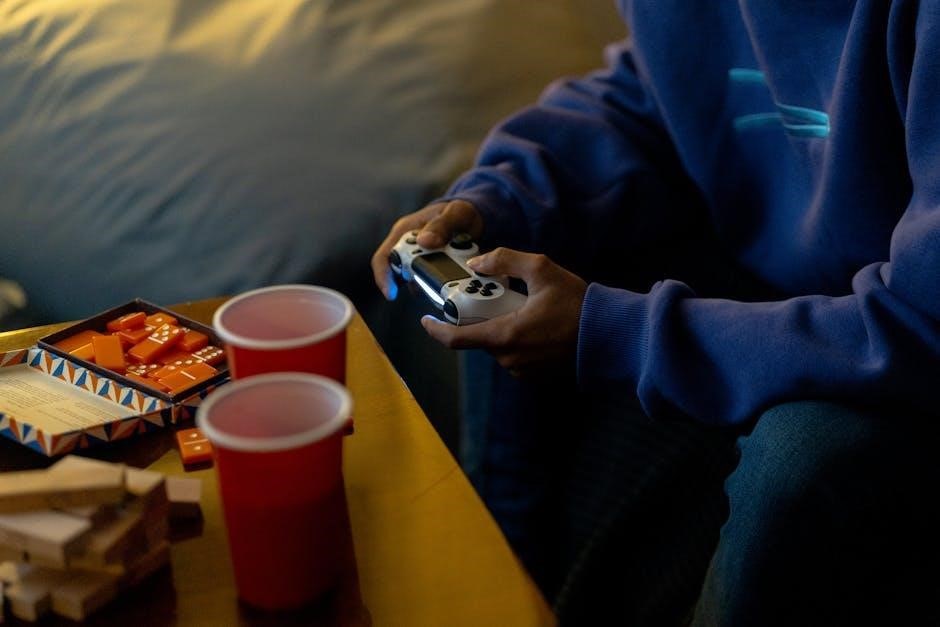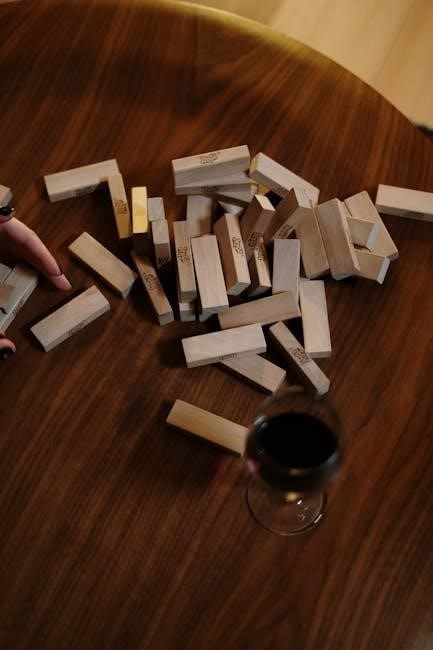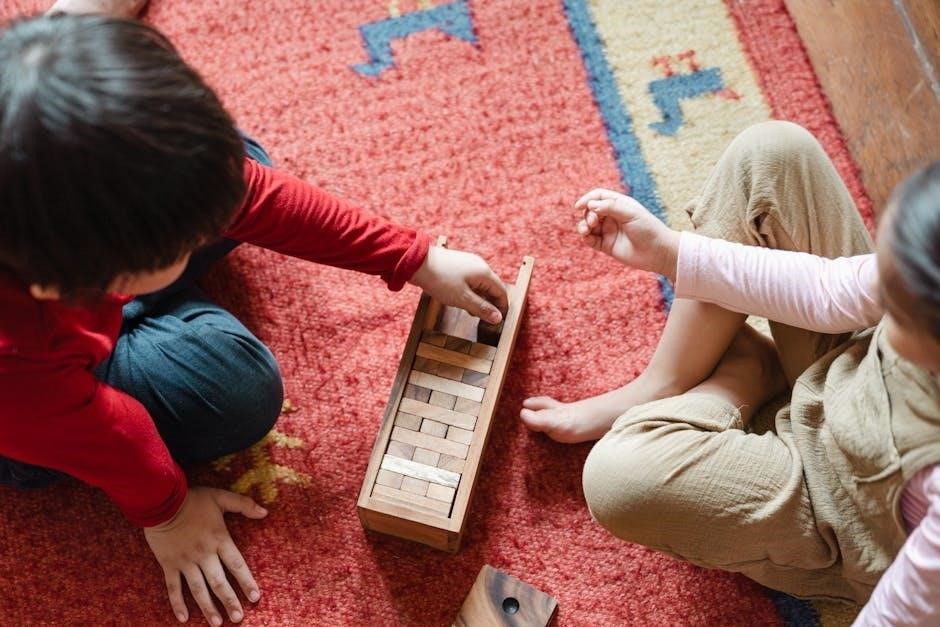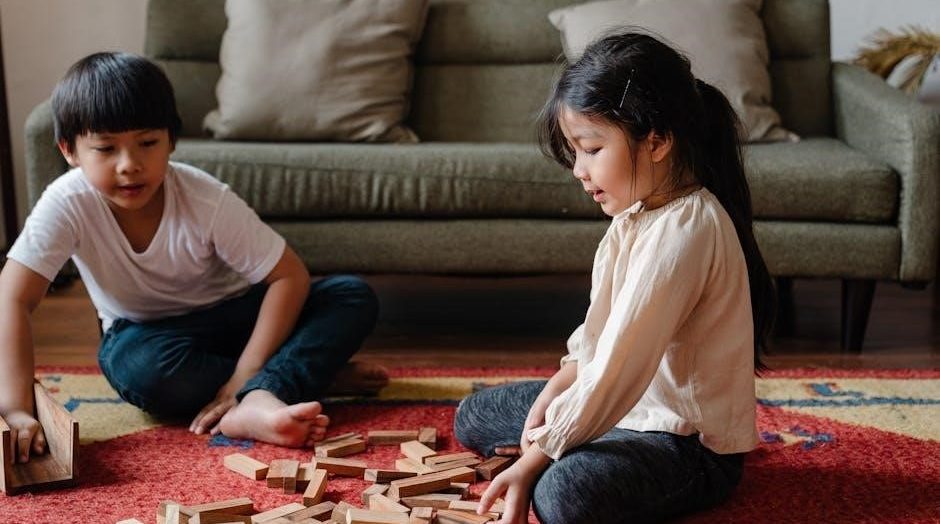Jenga is a classic physical skill game requiring precision and strategy. The official Jenga rules PDF, available from Hasbro, outlines setup, gameplay, and winning conditions. Understanding these rules ensures fair play and enhances enjoyment for all participants.
Overview of the Game
Jenga is a popular physical skill game where players take turns removing wooden blocks from a tower and balancing them on top. The objective is to be the last player to stack a block without causing the tower to fall. The game requires precision and strategy, making it engaging for players of all ages. Official rules, detailed in the Jenga rules PDF, ensure consistent gameplay across different editions and variations.
Importance of Understanding the Rules
Understanding the rules of Jenga is essential for fair and enjoyable gameplay. The official Jenga rules PDF provides clarity on setup, block removal, and winning conditions. Adhering to these guidelines ensures consistency, prevents disputes, and enhances the overall experience. Proper rule comprehension allows players to focus on strategy and skill, making the game more engaging and accessible for everyone involved.
Basic Setup and Equipment
Jenga includes 54 wooden blocks. To begin, empty them onto a flat surface. One player constructs the initial tower using the loading tray, alternating block directions.
Unpacking and Organizing the Blocks
The game includes 54 wooden blocks, which must be carefully unpacked and organized. Start by emptying the blocks onto a flat, stable surface. Use the provided loading tray to assist in constructing the initial tower. Each block should be aligned properly, ensuring the tower’s stability. Understanding the correct way to organize the blocks is essential for a fair and enjoyable game. Always handle the blocks gently to avoid damage.
Constructing the Initial Tower
To build the Jenga tower, start by placing three blocks side by side horizontally. Stack three more blocks perpendicular to the first layer, creating the second level. Continue alternating the direction of each layer, ensuring each block aligns with the one below it. Use the loading tray to assist in stacking. The tower should stand 18 levels high, with each level consisting of three blocks. This setup ensures stability and proper gameplay. Handle the tower gently to avoid premature toppling.
Core Gameplay Mechanics
Jenga involves taking turns removing blocks and stacking them on top. Players must balance precision with strategy to avoid causing the tower to fall.
Removing Blocks Safely
Players must carefully remove blocks from the tower using only one hand. A steady hand is crucial to avoid causing the structure to wobble or fall. The goal is to extract a block without destabilizing the tower. If the tower falls during your turn, you lose and must rebuild it for the next round. Always prioritize precision over speed to ensure safety and fairness in gameplay.
Stacking Blocks Properly
Stacking blocks involves placing the removed piece on top of the tower, ensuring it rests evenly and securely. Players must align the block with the existing structure to maintain balance. Proper stacking prevents wobbling and extends the game. Each block should be positioned horizontally, alternating directions with each level, as specified in the official Jenga rules PDF. Stability is key to a successful and enjoyable game for all participants.
Turn Sequence and Player Rotation
Players take turns in a clockwise or agreed-upon order, with each turn involving one block removal and placement. The sequence ensures fairness, allowing everyone equal opportunities. After a player successfully stacks a block, the next player takes their turn. If the tower falls, the player who caused it loses, and the next round begins with the last successful player. This rotation maintains engagement and ensures balanced gameplay for all participants.
Handling a Fallen Tower
If the tower falls, the player responsible loses the game. The next round begins with the last player who successfully stacked a block. The fallen blocks are rebuilt into a new tower. The game restarts, and the losing player is excluded from the next round. This rule ensures continuity and keeps the game exciting, as players aim to be the last to stack a block without causing a collapse.
Winning the Game
The last player to successfully stack a block without causing the tower to fall is declared the winner. This rule is clearly outlined in the official Jenga rules PDF.
Last Player to Stack a Block
The objective is to be the last player to successfully place a block on the tower without causing it to fall. If the tower collapses before a block is stacked, the player who removed the block loses. The game continues until only one player remains, who is declared the winner. The loser rebuilds the tower for the next round, ensuring continuous play.
Consequences of Causing the Tower to Fall
If a player causes the tower to fall, they lose the game. The last player to successfully stack a block before the collapse is declared the winner. The loser must then rebuild the tower for the next round. This rule incentivizes careful play and penalizes reckless moves, ensuring the game remains competitive and fun for all participants.

Official Jenga Rules
The official Jenga rules PDF, provided by Hasbro, outlines the game’s setup, gameplay, and winning conditions. It ensures fair play and clarity for all participants, making it essential for both casual and competitive games.
Standard Rules for Classic Jenga
Classic Jenga involves 54 wooden blocks arranged in an 18-level tower. Players take turns removing a block and placing it on top without causing the tower to fall. Each turn, a player must remove one block from any level below the topmost completed level. The block must be placed perpendicular to the blocks below to maintain stability. The last player to successfully stack a block before the tower falls wins the game. For detailed instructions, refer to the official Jenga rules PDF from Hasbro.
Special Edition Variations
Special editions of Jenga, like Jenga: Super Mario Edition and Tetris Jenga, introduce unique twists to the classic game. These variations often include themed blocks, altered winning conditions, or additional challenges, such as defeating characters or completing specific patterns. The official Jenga rules PDF for these editions outlines modifications to traditional gameplay, ensuring players adapt to new objectives while maintaining core stability and stacking mechanics. These variations enhance replayability and cater to fans of different franchises or gameplay styles.

Safety Tips and Precautions
Ensure a stable environment and use a flat surface to prevent accidents. Supervise children and avoid playing near breakable items to minimize risks during gameplay.
Ensuring Stability During Play
To maintain stability, always place the Jenga tower on a sturdy, flat surface. Avoid uneven or soft surfaces that could cause the tower to tilt or fall unexpectedly. Players should handle the blocks gently, ensuring each piece is securely placed before moving on. Regularly inspect the tower for balance issues and correct them promptly to prevent collapse during gameplay.
Avoiding Accidents
To prevent accidents, ensure the playing area is clear of obstacles and fragile items. Keep children and pets at a safe distance while the tower is standing. Handle blocks with care to avoid sudden movements, and never throw or force blocks into place. Supervise young players and encourage focus to maintain control during turns. A steady hand and patience are key to minimizing risks and ensuring a safe, enjoyable game for everyone.

Advanced Strategies
Advanced players master psychological tactics like misdirection and timing, while refining physical techniques for optimal stability. Strategic planning and precision are crucial for maintaining control and outperforming opponents.
Psychological Tactics
Psychological tactics in Jenga involve mind games to unsettle opponents. Players can use strategic timing, deliberate pauses, and subtle gestures to create pressure. Misdirection, such as focusing on certain blocks, can distract opponents, leading to mistakes; Building confidence through controlled moves can also intimidate, making opponents second-guess their actions. These mental strategies complement physical skills, enhancing overall gameplay effectiveness and increasing chances of winning. Mastery of psychological tactics separates casual players from champions.
Physical Techniques for Stability
Physical techniques for stability in Jenga involve using a steady hand to gently remove blocks, avoiding sudden movements. Proper gripping ensures control during extraction and placement. Aligning blocks carefully on top distributes weight evenly, preventing leans. As the tower grows, careful positioning and balance techniques are crucial to maintain stability and prevent toppling. Mastering these skills enhances gameplay and increases winning chances.

Common Variations and House Rules
Explore official variations like Jenga Xtreme and themed editions, or create house rules such as time limits, team play, or unique penalties for added excitement and challenge.
Time-Limited Games
Introduce excitement with time-limited Jenga games, where players race against the clock. Variations like Jenga Xtreme or Tetris Bop It incorporate timers, adding pressure and thrilling challenges. In some versions, if the tower falls within a set time, like 5 seconds, the player loses and must rebuild. This variation enhances the game’s intensity and tests players’ ability to remain calm under time constraints.
Team Play Modifications
Enhance Jenga with team play by dividing players into groups. Teams take turns removing and stacking blocks, combining strategy and collaboration. To add excitement, set a 30-minute time limit, with the highest-scoring team winning. In case of a tie, an extension round is played. This variation fosters teamwork and competitive spirit, making Jenga a dynamic group activity perfect for events or casual gatherings with friends and family.
Troubleshooting Common Issues
Common issues include the tower falling during play or disputes over rule violations. Rebuilding the tower and resolving disputes fairly ensure smooth gameplay continuation. Always follow official rules to maintain balance and enjoyment for all players.
Rebuilding the Tower
If the tower falls, the player who caused it typically rebuilds it. Using the original blocks, they must recreate the tower as it was before the collapse. Ensure all blocks are properly aligned and stable. If the tower falls during rebuilding, the same player retries. Rebuilding correctly is essential to continue the game fairly. Always refer to the official Jenga rules PDF for precise guidance on tower reconstruction.
Resolving Disputes
Disputes during gameplay should be addressed by consulting the official Jenga rules PDF. If a rule is unclear, players can agree on a resolution or appoint a neutral judge. The goal is to ensure fair play and maintain the game’s integrity. If a disagreement arises about a fallen tower or block placement, the rules provide clear guidelines to resolve the issue promptly and fairly.
Accessing the Official Jenga Rules PDF
The official Jenga rules PDF can be downloaded from Hasbro’s website. It provides detailed instructions for setup, gameplay, and winning conditions, ensuring clarity and consistency.
Downloading from Hasbro’s Website
Visit Hasbro’s official website and navigate to the Jenga section. Click on “Support” or “Rules” to find the PDF link. Ensure compatibility with your device. Follow prompts to download the guide, which covers setup, gameplay, and variations. Print or save for easy reference. This resource is essential for understanding official rules and enhancing your gaming experience.
Printing and Sharing the Rules
Once downloaded, print the Jenga rules PDF on standard paper. Share copies with friends or distribute at gatherings. Ensure all players have a copy for reference. This fosters clarity and consistency, making gameplay enjoyable for everyone. Store extras for future use or events, ensuring the rules are always accessible when the game is played.

Additional Accessories and Expansions
Enhance your Jenga experience with accessories like Jenga Xtreme for angled blocks or themed sets. Custom blocks and expansions add unique twists to the classic game.
Jenga Xtreme and Other Editions
Jenga Xtreme introduces angled blocks for added challenge, while editions like Super Mario and Tetris Jenga offer themed twists. These variations enhance gameplay with unique mechanics, such as character races or video game-inspired moves. Players can explore different strategies while maintaining the core block-stacking excitement. These editions are widely available and provide fresh ways to enjoy the classic game, keeping it dynamic and engaging for fans of all ages.
Custom Blocks and Themed Sets
Custom Jenga blocks and themed sets offer unique twists, such as Super Mario or Tetris editions, with specialized rules and designs. These sets often feature character-themed blocks or exclusive gameplay mechanics, enhancing the classic experience. Officially licensed themes add a personalized touch, allowing fans to combine their love for Jenga with favorite franchises. Custom blocks also enable players to create their own themed games, expanding the game’s versatility and fun for diverse audiences.
Common Mistakes to Avoid
Common mistakes include incorrect block placement and ignoring turn order. These errors can lead to unfair gameplay or early collapse of the tower, affecting everyone’s experience.
Incorrect Block Placement
Placing blocks incorrectly can destabilize the tower, increasing the risk of collapse. Always align blocks horizontally and vertically with the layer below. Misaligned blocks create instability, making the tower more likely to fall. Players must ensure each block is centered and even to maintain structural integrity. Failure to do so can lead to an unfair advantage or early termination of the game, penalizing the player who made the mistake.
Ignoring Turn Order
Ignoring turn order disrupts fair play and can lead to confusion or arguments. Players must take turns in sequence, as specified in the official Jenga rules PDF. Skipping or rearranging turns unfairly advantages some players, potentially altering the game’s outcome. Adhering to the established order ensures a balanced and enjoyable experience for everyone involved, maintaining the game’s integrity and competitive spirit. Disregarding this rule can lead to disputes and undermine the game’s fairness.
Hosting a Jenga Tournament
Organizing a Jenga tournament involves setting up a dedicated game area, establishing clear scoring criteria, and ensuring all participants follow the official Jenga rules PDF. This setup guarantees a fair and exciting competition for all players.
Setting Up the Game Area
To host a successful Jenga tournament, ensure the game area is flat, sturdy, and free from distractions. Use the loading tray to organize blocks and construct the initial tower. Place the tower centrally, ensuring stability and equal access for all players. Maintain spacing between blocks for easy removal and avoid loose clothing or jewelry that might interfere. A well-prepared setup enhances focus and fair play.
Scoring and Judging Criteria
Scoring in Jenga tournaments is based on the last player to successfully stack a block without causing the tower to fall. Judges evaluate stability, precision, and adherence to rules. Points may be awarded for height achieved or blocks placed without toppling the tower, ensuring fair and competitive gameplay. The winner is determined by these criteria, fostering a balanced and exciting tournament experience for all participants.

The Future of Jenga
The future of Jenga involves new editions and innovations, such as themed sets and community-driven rule changes, ensuring the game remains fresh and engaging for players worldwide.
New Editions and Innovations
Recent innovations include themed editions like Jenga: Super Mario Edition and collaborations such as Tetris Jenga, blending classic gameplay with new twists. Jenga Xtreme introduces angled blocks for added challenge. These editions expand gameplay possibilities while maintaining core rules, ensuring the game stays fresh and exciting for both longtime fans and newcomers. Such innovations keep Jenga relevant and engaging across generations.
Community-Driven Rule Changes
Players often create unique variations, such as time limits or team play, to enhance gameplay. These community-driven changes, while not part of the official Jenga rules PDF, add fresh twists. For instance, some groups introduce a timer to increase pressure, while others allow team collaboration. These adaptations keep the game dynamic and tailored to different preferences, ensuring endless fun and creative challenges for enthusiasts worldwide.
